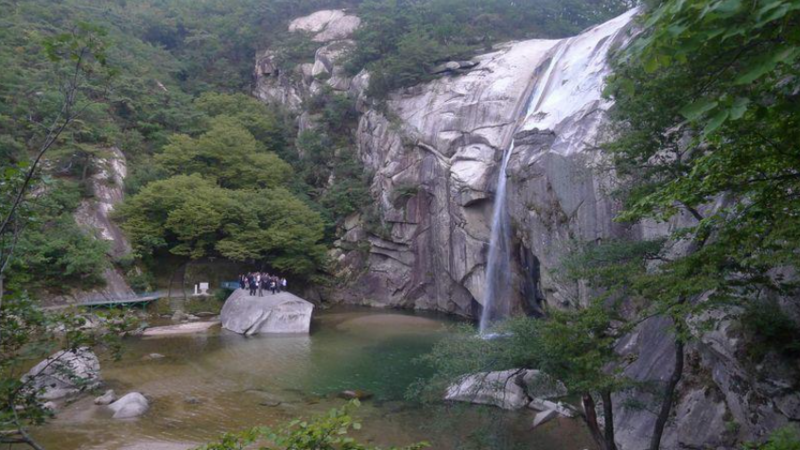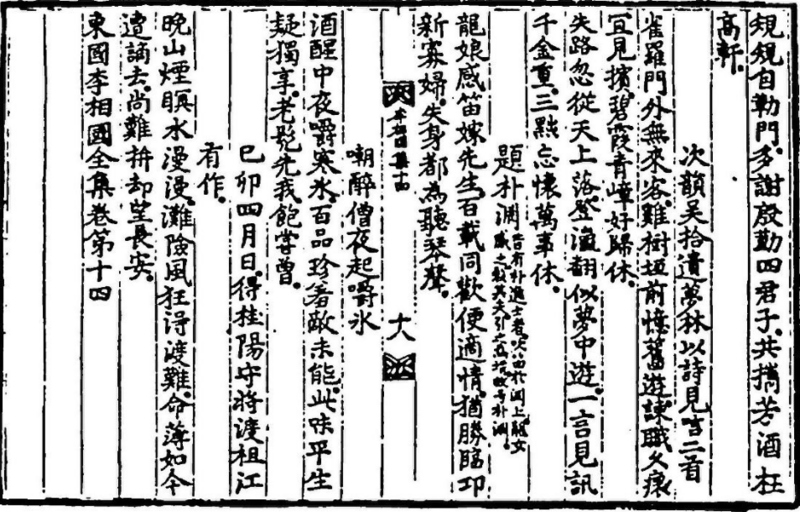Dive into the Culture and History of Pakyon Falls in North Korea, One of Korea’s “3 Great Waterfalls”
The Pakyon Falls in North Korea is located in Kaesong. Pakyon Falls is not only a picturesque natural wonder but also a remarkable location in North Korea rich in historical and cultural significance.
If you are going to visit there with Koryo Tours someday, don’t forget to read this before you set out.
This is the most comprehensive and the only English source available on the internet that introduces the culture and history behind Pakyon Falls in North Korea.
Check out our handy Travel Guide on Pakyon Falls in North Korea
Where is Pakyon Falls (North Korea)?
Pakyon Falls is a waterfall located in the Ahobiryong Mountains (Tiger Leaping Peak) in North Korea.
You can visit it along the Pyongyang-Kaesong highway.

The Pakyon Falls
Why is Pakyon Falls Famous?
One of Korea’s 3 Great Waterfalls
The simplest reason for Pakyon Falls being so famous is that it is an incredibly picturesque spot.
Pakyon Falls in North Korea (Kaesong), along with the Kuryong Falls of Mount Kumgang and Daeseung Falls of Mount Seorak, have been known as the three great waterfalls of Korea since ancient times.
Throughout history, many scholars and poets have visited these waterfalls to write poems and draw paintings about them, thereby adding further cultural significance to these natural wonders.
Pakyon Falls, together with Hwang Jin Yi and So Gyong Dok, are collectively referred to as the "Three Superb Prides of Songdo" (송도삼절). Songdo, meaning "the capital of pine" in Korean, refers to the ancient capital of the Koryo Dynasty – Kaesong.
Hwang and So were famous literati from Kaesong. You can easily tell from Hwang and So’s names that they were human. However, it is quite surprising that Pakyon, a word that sounds like a classical Korean name and ranks alongside theirs, is not a person at all.
It is simply a place name. This makes it all the more strange.
Folk Music about Pakyon Falls in North Korea
As a national treasure since ancient times, the Korean people have sung the praises of Pakyon Falls for centuries. We can still hear songs about Pakyon Falls on both the north and the south sides of Korea today.
A music video of the traditional Korean folk song “Pakyon Falls” produced by the DPRK can be found here on YouTube.
The lyrics of this song continually praise the beauty of Pakyon Falls and its surrounding landmarks, such as Bomsa Temple and Manwoldae, until the final line takes a surprising turn and shifts to a theme of love: "Will our hearts change again?"
This line feels rather abrupt, much like Pakyon standing between the two human names Hwang and So—an oddity that prompts one to wonder about its deeper meaning.
Let’s set aside the answer for now, as the reason behind this curious shift will become clearer once we explain the origin of the name Pakyon in the following sections.
What Does ‘Pakyon’ Actually Mean?
Before diving into some ancient Korean folklore to uncover the real meaning of Pakyon, let's first consider the simplest explanation.
This explanation is quite straightforward, suggesting that Pakyon Falls is a waterfall flowing into a pool shaped like a gourd. So, in this explanation, Pak (박) means gourd, and Yon (연) means pool, put them together then you can get the term Pakyon.
The Original Folklore of Pakyon
There is folklore evolving about Pakyon depending on time. Let’s take a look at the original version first.
This may be the story you will hear from your local Korean guide when you visit DPRK with us in the future.
Once upon a time, there was a Jinsa (a successful candidate in the highest imperial examinations) with the surname Pak, who often played the flute by the waterfall at night. One day, the dragon king's daughter swam to the waterfall, saw Pak, and fell in love with him. She expressed her affection, and soon the two were deeply attracted to each other, forming a bond so strong that they vowed to stay together for the rest of their lives. From then on, the couple lived happily ever after in the dragon palace.
So, it is obvious now why there is a line about love in the Pakyon Falls song.
However, the ending of the story was not so perfect.
The couple left without informing Pak’s single mother.
Noticing his prolonged absence, Pak’s mother went to search for him near the waterfall. In her deep grief, she accidentally fell into the pool beneath the waterfall.
Consequently, the pool got its name - Aunt Pool (고모담), also known as Mother Pool (어미담). In this version of the folklore, Pak refers to the surname, Yon means deep pool.
The Evolved Version of the Folklore
As time flowed, the folklore has evolved into a different version. This version of the folklore is kind of morbid and dark.
Everything was the same until the dragon king’s daughter swam to the waterfall and saw Pak.
Pak seduced the dragon princess on his own initiative, making her infatuated with him unilaterally. As a result, the dragon princess killed her original husband and dragged Pak into the dragon palace underwater, forcing him into marriage.
Since Pak was not the Aquaman and could not breathe underwater, he soon met an unfortunate end. Sadly, His mother's fate was the same as in the original version.
This version of the folklore is recorded in the preface of the poem "제박연" (题朴淵, Written at Pakyon) by Ri Gyu Bo, one of the best poets of the Koryo dynasty.
The content of the poem and a simple translation are as follows:
昔有朴進士者, 吹笛於淵上。龍女感之, 殺其夫, 引之爲壻, 故號朴淵。(Preface)
옛날 박 진사란 사람이 못가에서 피리를 부니, 룡가 그 피리 소리에 반하여 저의 본 남편을 죽이고 박 진사에게 시집갔으므로, 이 못을 박연이라 이름했다 한다.龍娘感笛嫁先生, 피리 소리에 반한 룡녀 선생께 시집오니,
百載同歡便適情. 오랜 세월 그 정열 즐겁기만 했겠지.
猶勝臨邛新寡婦, 그래도 임공의 새 과부가,
失身都爲聽琴聲. 거문고 소리에 미쳐 달려온 것보다는 나으리.
Moved by the flute, the dragon lady married the scholar (Pak). A hundred years of joy and love, they led a happy and blissful life. This marriage is even better than the Lingong new widow’s marriage.
They both fell in love because of music. (The Lingong widow refers to Zhuo Wenjun, a famous female writer of the Han Dynasty in China.)

Collection of Poems of Ri Gyu Bo. (Copyright: Institute for the Translation of Korean Classics, ROK)
Why did the folklore of Pakyon Falls change?
The differing stories from the times reflect changes in social consciousness and the social status of Korean women over time.
During the early period of the Koryo dynasty, Korean women were relatively freer and had more rights. They could freely mingle with men, own possessions, and inherit land.
As Neo-Confucian Philosophy gained more and more influence in Korea, women's status declined significantly, making them almost become subordinate to men. The latter version reflects the suppressed social status, female consciousness and demonisation of women during that era.
A Hwang Jin Yi’s Poem about the Pakyon Falls
When you visit Pakyon Falls, you can step on a rock near the waterfall called Ryong Bawi (the Dragon Rock) where you can spot engraved chirography of Hwang Jin Yi, one of the three Superb Prides of Songdo.
The sentence engraved was “飛流直下三千尺,疑是銀河落九天” (Its torrent dashes down three thousand feet from high as if the Silver fell from the blue sky) from a poem about the waterfall of Mt. Lu by Li Bai, the greatest Chinese poet ever.
It is said that when Hwang was admiring the waterfall, her hair became wet from the splashing water. Seeing the dreamlike scene before her, she spontaneously wrote her exclamation with her hair. It is believed that this mark is the original trace she left with her hair.
The Introduction Stele of the Dragon Rock and Hwang’s Chirography
Pakyon Falls Poem
Hwang Jin Yi is a famous Kisaeng of Kaesong and one of the most famous women in Korean history. Though she used Li Bai’s sentence to praise the magnificence of Pakyon Falls, she has written a poem about the waterfall, too.
The title of Hwang’s poem is “박연폭포” (朴淵瀑布, Pakyon Falls). The content of this poem and translation is as follows:
一派長川噴壑礱,한 가닥 하늘폭포 같은 물줄기 골짝으로 떨어져,
龍湫百仞水淙淙。룡추 백 길 물이 펄떡이듯 튀는구나.
飛泉倒瀉凝銀漢,흩날리는 물보라가 곤두선 은하수인 듯,
怒瀑橫垂宛白虹。기세 등등 폭포수가 흰 무지개로 드리웠네.
雹亂霆弛彌洞府,날리는 우박, 치닫는 우렛소리 골짝에 가득 차고,
珠者玉碎徹晴空。옥구슬 가루 마냥 푸른 하늘 꿰뚫는구나.
遊客莫道廬山勝,나그네여, 려산폭포만 좋다고 마소,
須識天磨冠海東。천마산의 이 폭포가 해동 으뜸이라오.
One big stream of water is falling from the sky into the valley. Apparently dragon-like waters of one hundred feet make splashes With sprays flying away like the vertical Milky Way. The triumphantly roaring sounds spread out like a white rainbow. Running hails and roaring thunders are filled in the valley. As if beads are scattered and jade is crushed, the sprays are soaring to the blue sky. Hey, man, don't tell me Lushan Fall is the best. Here the heavenly carved waterfall is the Best in the East.
(Translated by ex-Prof. Whon-il Park of Kyung Hee University)
In this poem, Hwang used skilful and exquisite language to depict the majestic scenery of Pakyon Falls. In the last verse, Hwang considered Pakyon Falls is even more magnificent than the waterfall of Mt. Lu, which not only highlights the grandeur of Pakyon Falls but also reflects Hwang’s strong sense of national pride.
Pakyon Falls is a national treasure of the DPRK. Along with the nearby temples and historical sites, it offers a relatively comprehensive reflection of the fascinating history of the Koryo and Choson eras.
When visiting here with Koryo Tours, you will receive thorough and rich knowledge and have the opportunity to hear narratives from the DPRK’s perspective on history. If you're interested, add it to your to-visit list, as the DPRK border reopening is steadily progressing.

